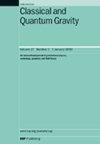比较基于后牛顿法和有效单体法的偏心波形模型
IF 3.7
3区 物理与天体物理
Q2 ASTRONOMY & ASTROPHYSICS
引用次数: 0
摘要
在本研究中,对两个数值模型进行了比较,即 CBWaves 和 SEOBNRE 算法,它们分别采用后牛顿方法和有效单体方法开发,用于研究在偏心轨道上演化的双黑洞。为了绘制两个模型之间的不匹配图,我们在参数空间的共同参数值网格上进行了 260 000 次模拟--20 000 次为非自旋构型,240 000 次为自旋构型。这个空间是由质量比、以 i 标记的每个分量的重力质量、相应的自旋幅度和恒定的初始轨道偏心率 e0 定义的。为了确定两种编码生成的波形是否存在差异,我们进行了全面的调查。这就需要对不匹配现象进行深入分析,并对两种编码的离群点进行广泛比较。本文章由计算机程序翻译,如有差异,请以英文原文为准。
Comparing eccentric waveform models based on post-Newtonian and effective-one-body approaches
In the present study, two numerical models were compared to each other, namely the CBWaves and SEOBNRE algorithms, developed using the post-Newtonian and effective-one-body approaches, respectively, for the study of binary black holes evolving on eccentric orbits. To map the mismatch between the two models 260 000 simulations were conducted – 20 000 for non-spinning configurations and 240 000 for spinning ones—on a common grid of parameter values over the parameter space. This space is defined by the mass ratio , the gravitational mass of each component labeled by i, the corresponding spin magnitude and a constant initial orbital eccentricity e0. A comprehensive investigation was conducted to determine whether there was a discrepancy in the waveforms generated by the two codes. This entailed an in-depth analysis of the mismatch, and an extensive comparison was carried out on the outlier points between the two codes.
求助全文
通过发布文献求助,成功后即可免费获取论文全文。
去求助
来源期刊

Classical and Quantum Gravity
物理-天文与天体物理
CiteScore
7.00
自引率
8.60%
发文量
301
审稿时长
2-4 weeks
期刊介绍:
Classical and Quantum Gravity is an established journal for physicists, mathematicians and cosmologists in the fields of gravitation and the theory of spacetime. The journal is now the acknowledged world leader in classical relativity and all areas of quantum gravity.
 求助内容:
求助内容: 应助结果提醒方式:
应助结果提醒方式:


